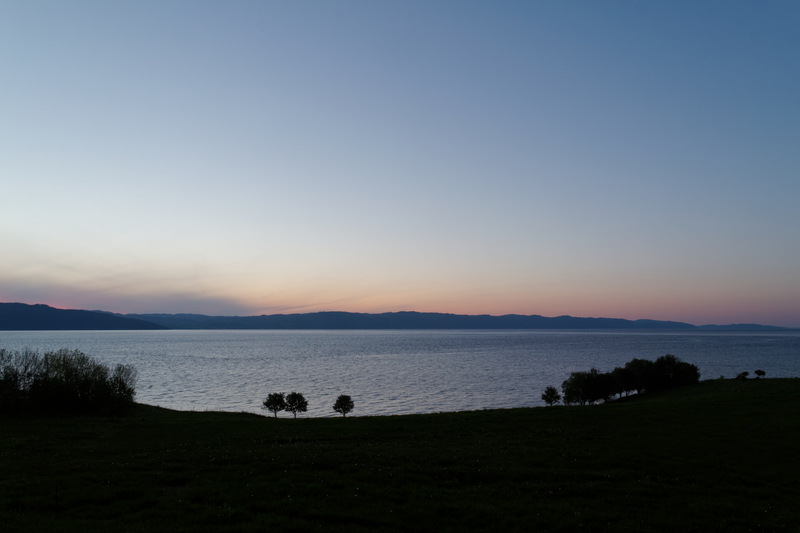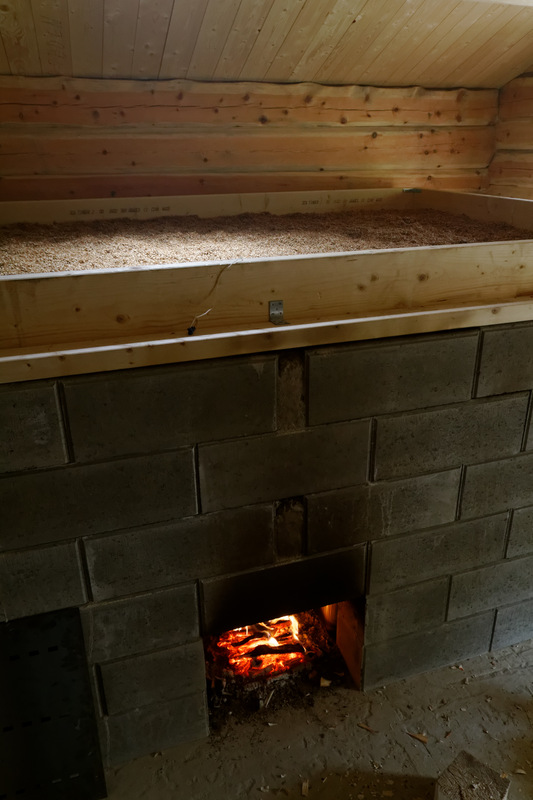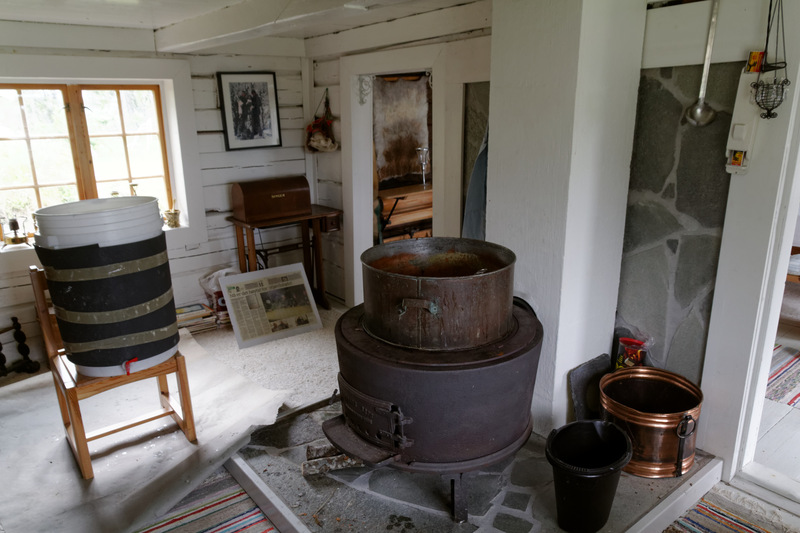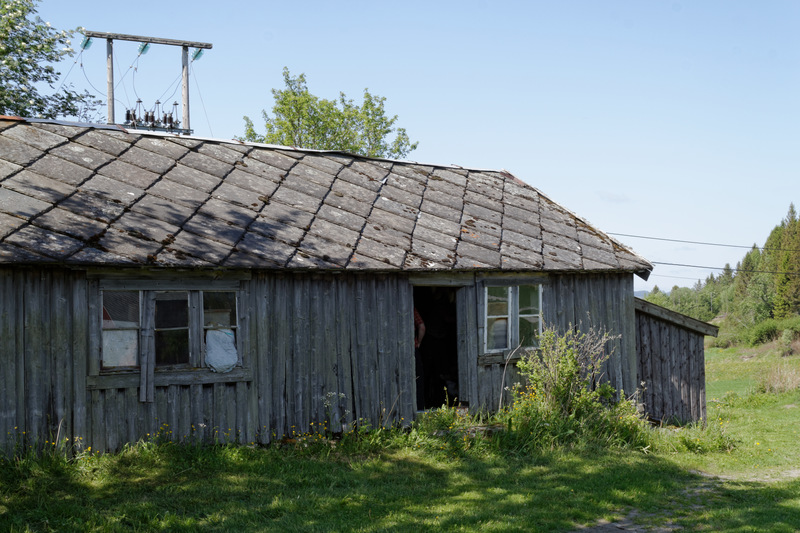Alstadberger

View from my room at Klostergården, Tautra |
Driving hurriedly on from Storli Gard, we arrived at the island of Tautra outside Trondheim late at night. There lies Klostergården, which is a farm, an inn, a restaurant, a bar, and a brewery, all in one. The name means "monastery farm", because it's literally right next to the ruins of a medieval monastery. The brewery is a small craft brewery, and on this tour we weren't really looking for craft beer, but in this case we made an exception. (This is part 8 of the Norwegian farmhouse ale trip.)
At the brewery, we were met by Jørn Andersen, the brewer, and his father Ståle. The farm is actually the family farm, now in the seventh generation. Jørn started out as a modern-style home brewer in the American tradition, but Tautra is not very far from Stjørdal, the place in Norway most famous for its farmhouse ales. In Stjørdal, malting is seen as an essential part of the brewing process, and so most brewers do their own malting, and the smoked, roasty malt character is considered a key characteristic of the beer.

Klostergården, main building |
Through the Christmas beer competitions they arrange at Klostergården Jørn got to know Roar Sandodden, a home brewer from Skatval, not far away. They decided to brew a craft version of the local farmhouse ales, known as stjørdalsøl, using malts from Roar. The beer, Alstadberger, is a scaled-up version of Roar's normal Christmas beer, using local malts. This beer, and the great location with rooms to stay over, was why we'd decided to pay them a visit.

Jørn pouring a beer in the barn |
After checking into our rooms we assembled in the old barn, which has been converted to a quirky modern bar. They had a good number of beers on, but our focus was of course the Alstadberger, so Jørn poured us each a glass of that. The colour is hazy brown, the head beige. I give it a swirl, then smell it: earth, smoke, dried fruit, and some wild berries. Taking a sip, I find it's fairly sweet, caramelly, and smoky, with some juniper, ash, and herbs. It's soft, mild, and rounded in the mouth. Juniper and smoke flavours linger for a long time.

Alstadberger |
I've had a couple of different batches of the Alstadberger, and liked it very much. The first time I had an excellent IPA after it, and felt the IPA was kind of a let-down. I'm not alone in liking it: it's been very well received on Ratebeer and by local enthusiasts. The local government alcohol monopoly stores stocked the beer, but it was so popular that despite being rather expensive it sold out in a few hours. After the Alstadberger we had another beer, but then it was time to call it a day, as it was getting on for midnight, and we had a programme for the next day as well.
After breakfast the next day we headed off to deliver our car, and Jørn then kindly drove us to Roar's house, which is in Alstadberg, hence the name of the beer. Roar has just built a new malting house, known locally as a "såinnhus". In fact, it's so new it wasn't entirely finished yet, so for the first batches of Alstadberger, Roar borrowed the malt houses of neighbours to make the malts. As luck would have it, Roar was malting when we arrived.

The såinnhus |
Roar's såinnhus is a small log cabin next to the forest. It's not completely finished yet, but has come far enough that he can malt in it. He buys the barley (type Tyra) from his neighbour. He soaks it for two days, changing water twice, then airs it for a couple of hours. It's transferred to a growing frame where it grows 4-5 days, depending on temperature. While it's growing he stirs it thoroughly three times a day. After that it's ready for drying on the malting oven.

Malt frame, on top of oven |
Inside the såinnhus the actual malting oven follows the traditional specifications exactly. A wooden frame about 20cm deep holds the malts, and sits about 1.6 meters above the floor, on a brick oven. The bottom of the frame is made of wooden boards with lots of little holes drilled in them, to let heat and smoke through. At floor level is the actual fireplace, called "kjerringa," which is a term so ambiguous it's almost untranslatable, but let's say it means "the woman." In any case, it needs careful attention throughout the process.
In the oven he burns dry alder wood, chopped fine, so it burns well with a nice even air flow through the malts. As we found in Voss, the alder wood smoke gives a special aroma. Once the malt is dried he removes the shoots and the tendrils using a machine. So he's not one of the people Harald Storli complained about.

Malt oven, with "kjerringa" at the bottom |
Next to the såinnhus is the brewhouse, which is from the 19th century. The inside is beautifully decorated in modern style, while preserving the rustic feel of the original house. The brewkit is almost identical to the ones we've seen before. On top of an iron stove sits a big metal kettle. Next to it, on a chair, stands the mash tun/fermenter.

Brewkit |
The actual recipe is somewhat modernized. Roar says the juniper flavour was never an essential part of the local ale, so he's dropped it completely. He uses 60% local malts, plus Maris Otter and crystal malts. The hops are Admiral and Saaz, and the yeast is London Ale III. He uses a form of decoction mashing where he takes out some of the mash, heats it up, then pours it back. This sounds like the "tvimesk" that Harald Storli used, but it's not clear if it's the same. Although most of the ingredients are modern, the process and the equipment are still traditional. The result is a beer well suited for craft production, unlike some of the more traditional beers we've tried.
Having toured the såinnhus and the brewery, we sit down at a table in Roar's garden, to taste his homebrew. He serves two, one dark and one pale, both modern in style. They're both excellent beers, clean and fresh-tasting. The kids bring out a plate of waffles, allowing us to enjoy our first lunch that isn't heavy on the meat.
As we sit there in the sunshine, the conversation goes in all directions, but it's quickly clear that Jørn and Roar are well aware that they are part of a unique tradition, and that taking this into the world of craft beer would mean doing something that's different from everyone else. They've already thought of combining kveik with local malts and Norwegian hops, in which case you'd have an entirely Norwegian product.

Roar pouring homebrew |
We ask Roar where he learned to brew and malt, and he says he learned from the neighbours. The malting and farmhouse brewing in the area declined throughout the 20th century until about 1990. Around that time there was a revival that is still going on. The local brewers started gathering at a cabin in the woods for a tasting every December 26. A couple of decades ago they were not very many, but now it has expanded to such an extent there are actually five separate tastings. Roar estimates there are about 300 to 500 different beers on offer at these tastings. (No, that's not a typo. There really are that many farmhouse brewers here.)
According to Roar there are regional differences within the area. For example, in Skjelstadmarka, part of Hegra, they smoke the malts harder than elsewhere. But there are also big individual differences, so people living right next to one another can make completely different beers. Kveik doesn't seem to exist here, and most brewers ferment with bread yeast, just like Harald Storli.

The "eldhus" |
Although nobody in the area uses kveik any more, Roar and Jørn know that a nearby farm had it until some decades ago. The old wooden fermentation vessels are still there, and should have residue on the bottom. So perhaps the yeast could be revived? The farm also has a malthouse from the 19th century, so Roar suggests we head over to have a look. We're of course more than happy to come along, and Jørn kindly drives us a couple of kilometers to Hegge farm.

The malt oven |
First we stop by the eldhus. This literally means "fire house", and was used for activities that involved a fire. In this case, baking, malting, and smithwork. The house has been left pretty much as it was, except the baking oven is gone. One side, with an anvil and other tools, was clearly for smithwork. In the middle is the malt oven. It's made from wood and dirt mixed with straw. The shape, however, is nearly identical to Roar's new one. The fireplace is in the same place, the dimensions are the same, and the frame on top is the same.
Eventually we leave the eldhus and walk over to where Olav Hegge, the brewer, is sitting on a swing, waiting for us. Olav is getting old now, but he still brews. They've brewed their own beer for Christmas every year without exception, he says proudly. He takes us down into the cellar to show us the brewery. It's very similar to the one at Storli, with the same kind of oven, wooden storage casks, and so on. He has a metal mash tun, though.

Olav with a wooden cask |
Having seen the brewery, Olav takes us to what he calls his "museum", an old food storehouse where he keeps all kinds of old farm equipment and other memorabilia. We go up to the second floor. Here, says Olav, is the old fermentation tun. Olav, Roar, and Jørn start moving away things so we can get at it. Eventually, they bring out an old wooden cask. It has only a tiny opening on top, so it's hard to say what's in it. We shine the flashlight on a cell phone through the opening and see some white residue on the bottom. Could be dried yeast. Could be dust.

Hunting for kveik |
Olav says after fermentation they would usually just let the remains in the tun dry out, without cleaning the tun. Thus it really could be yeast that's in there, but, he says, it must be around 40 years old. The trouble is, the opening on top is so small we can't really reach the residue. Scratching it off looks hard, and it's not clear it would do any good, either.
Roar and Jørn talk about pouring in some wort to attempt to revive it. Thinking back to professor Delvaux's attempts to revive similarly-aged yeast from de Kroon I'm skeptical. If he couldn't do it it probably can't be done. It's really sad, but it looks like this piece of our brewing culture is gone forever. It's a poignant reminder of how much we've lost, even if the traditional brewing culture has survived and is still going strong.
From what we've heard it's already clear that Trøndelag must have the biggest concentration of farmhouse brewers in the country. It's probably no accident that this also is the first place where the farmhouse ales have made it into commercial production, and where the craft brewers are actively planning to move more of the tradition into production. This is in my opinion a natural next step for farmhouse brewing, making these beers available to many more people. The difficulty is doing this without turning what was a unique farmhouse ale into "just" another craft beer.
The Alstadberger is a first step on this road, and to my mind it's a very successful one. It doesn't really have the same flavour as the farmhouse ales (as you'll saw in the previous post, and as you'll see in the next), but it is an excellent beer that's markedly different from a porter or rauchbier. You could argue that it's Norwegian craft brewers using Norwegian traditions to produce craft beer that a Norwegian profile, rather than simply being copies of foreign styles.

The smithy in the eldhus at Hegge |
And with that we're ready to leave Skatval for our next stop, Hegra.
Similar posts
Hegra maltøl at Granås Gård
Our final stop on the trip was actually the first to be planned
Read | 2014-09-09 17:20
Stjørdalsøl — the tasting
During our 2014 farmhouse ale expedition, Martin and I visited Stjørdal, a region in Norway famous for the many farmhouse brewers who still make their own malts in the traditional way
Read | 2017-03-09 14:58
Traditional malting in Morgedal
The guys I visited in Morgedal were definitely brewing traditional farmhouse beer, but they bought the malts
Read | 2015-11-21 13:09
Comments
Roar Sandodden - 2014-09-04 07:31:07
Thanks for visiting. A story well written. Welcome back. I guess 26th December would be a good date :-) Roar
Lars Marius - 2014-09-04 08:08:00
Thank you, Roar. I've wanted to go there on the 26th for years, but for some reason my wife and daughter have never been very keen on the idea of celebrating Christmas in a hotel in Trondheim. :)